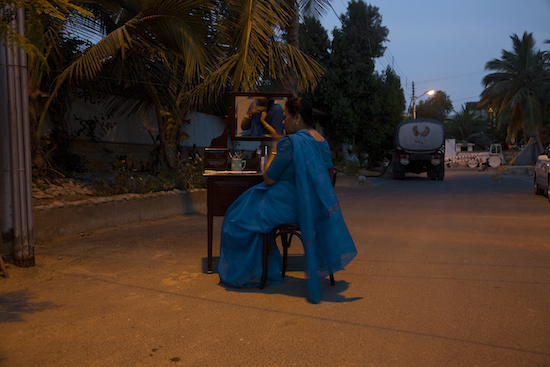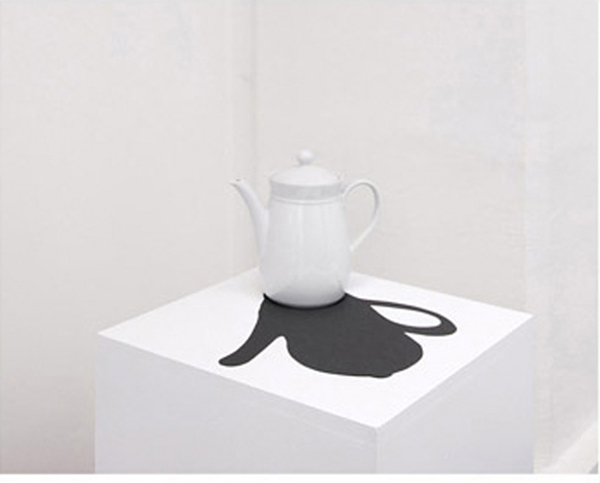Mimbres pottery kill hole sequence
- Installation (Installation)
Mariana Castillo Deball
Mariana Castillo Deball’s set of kill hole plates are part of a larger body of work problematizing archeological narratives, and drawing attention to the conservation process and its role in recreating an imagined object. They are playful and exaggerated representations of “kill hole pottery” — ceramic dishes in the Mimbres tradition with distinct circular holes located in the center of the pots. Although very little is known about the Mimbres culture’s specific beliefs, they are loosely understood to have terminated the object symbolically in preparation for funerary use. (A common belief is that kill holes served as a conduit to a spiritual world.) When these ceramics were first discovered, however, there was no scholarly precedent to explain the kill holes or differentiate them from the more common broken sherds of most ancient ceramics, so as a result hundreds of these pots were mistakenly repaired. It wasn’t until more kill hole ceramics were unearthed, and sufficient information was collected, that kill holes were understood as intentional absences, punched into the ceramics as a significant act of negation. Deball’s foregrounding of these pots in her recent project was meant to heighten the kind of leaps made around found artifacts through imagined realities, signaling the anxiety of Modernity—the irretrievable loss of information— and highlight the important work of responsibly decoding the gaps of information.
The practice of Mariana Castillo Deball (b. Mexico City, 1975) is centered on intensive research. In weaving together perceived facts and legends, the artist deconstructs how we understand tradition, liberating content from imposed ideological legacies. Mariana Castillo Deball’s collaborative research—in particular in the domain of science, geology, archaeology and literature—is manifested and synthesized into her multimodal sculptural practice. The archive is a significant aspect of the artist’s practice, whereby the research conducted in the creation of her sculptures is culminated, catalogued and preserved. Deball is not only interested in traces of the past, her multidisciplinary approach allows her to study the different ways in which a historical object can be read today.
Colors:
Other related works, blended automatically

© » KADIST
Mariana Castillo Deball
2015Taking archaeology as her departure point to examine the trajectories of replicated and displaced objects, “Who will measure the space, who will tell me the time?” was produced in Oaxaca for her exhibition of the same title at the Contemporary Museum of Oaxaca (MACO) in 2015...

© » KADIST
Bani Abidi
2008The threshold in contemporary Pakistan between the security of private life and the increasingly violent and unpredictable public sphere is represented in Abidi’s 2009 series Karachi ...

© » KADIST
Bani Abidi
2012The perceived effortlessness of power, projecting above experiences of labored subordination is examined in Death at a 30 Degree Angle by Bani Abidi, which funnels this projection of image through the studio of Ram Sutar, renowned in India for his monumental statues of political figures, generally from the post-independence generation...

© » KADIST
Bani Abidi
2008The threshold in contemporary Pakistan between the security of private life and the increasingly violent and unpredictable public sphere is represented in Abidi’s 2009 series Karachi ...

© » KADIST
Mario Garcia Torres
2010In Up All Night, Waiting for the Chelsea Hotel Magic to Spark My Creativity Mario García Torres constructs and documents a hypothetical scene, situating himself within a lineage of artists and creatives that used to congregate at the historic hotel...

© » KADIST
Hans-Peter Feldmann
The types of objects Feldmann is interested in collecting into serial photographic grids or artist’s books are often also found in three dimensional installations...

© » KADIST
Harrell Fletcher
2005The American War , which takes its title from the Vietnamese term for what Americans call the Vietnam War, has toured the United States extensively with the goal of presenting a Vietnamese perspective of that history...

© » KADIST
Erick Beltran
2010In his posters, prints, and installations, Erick Beltrán employs the language and tools of graphic design, linguistics, typography, and variations in alphabetical forms across cultures; he is specifically interested in how language and meaning form structures that can be misconstrued as universal...

© » KADIST
Julio Cesar Morales
2008The video Interrupted Passage presents a performance Morales staged in the former home of Mariano Guadalupe Vallejo, a mid-nineteenth-century Mexican general serving in California...

© » KADIST
Mario Garcia Torres
2004Mario Garcia Torres imagines cinematic devices to replay stories occasionally forgotten by Conceptual art...

© » KADIST
Adrian Villar Rojas
2012Based on historical prophecies and fantasy, the artist creates apocalyptic scenarios that posit an enigmatic world plagued by social, political, and environmental upheaval...

© » KADIST
Julio Cesar Morales
2006Julio Cesar Morales’s watercolor drawings, Undocumented Intervention , show a variety of surprising hiding places assumed by people trying to cross into the United States without documentation...

© » KADIST
Jonathan Hernández
2008In line with Hernández’s interest in catastrophe, Vulnerabilia (choques) is a collection of images of shipwrecks and Vulnerabilia (naufragios) collects scenes of car crashes...

© » KADIST
Pablo Rasgado
2011Pablo Rasgado’s paintings and installations serve as a visual record of contemporary urban human behavior...

© » KADIST
Oliver Laric
2012Oliver Laric’s video Versions is part of an ongoing body of work that has continued to evolve and mutate over time...

© » KADIST
Julieta Aranda
2016The video Swimming in rivers of Glue is composed of various images of nature, exploring the themes of exploration of space and its colonization...

© » KADIST
Agnieszka Kurant
2018Agnieszka Kurant’s Placebo VIII brings together a series of imaginary pharmaceuticals invented within the fictional narratives of literature and film...



